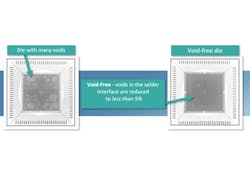Successful Void-Free Die Attach Using Vacuum Reflow Systems
Introduction
There are many factors to consider when it comes to achieving desirable die attach; one of the most important of these factors is solder interface voiding. Voids in the solder interface contribute to various failure modes including overheating via non-uniform dissipation of heat and high mechanical stresses.
Vacuum reflow systems offer solutions to achieve low solder interface voiding through chamber pressure manipulations and surface treatment options. In addition, the correct solder material selection is key to achieving excellent bond quality. Each application is unique and requires careful consideration when it comes to solder material selection.
Selecting the proper material, solder, and process/tooling selection are essential to provide a successful void-free die attach using a vacuum reflow system.
Void-Free – What is it and Where is it Needed?
Void-free bonding is defined as voids in the bonding material interface, for example, solder, that is equal to or less than 5% of the interface area.
Creating a void-free bond can be critical because voids in the interface bond degrade product performance and reliability. The more demanding the application (either in terms of higher power or improved specifications), the greater the need is to have as little void as possible in the bond.
Void-free is critical where ever high-power, high performance, high efficiency, and long-life reliability are important. For example, some specific applications include devices for aerospace, defense, submarine, life-critical medical devices, high-power electronics, high-performance sensors in EV Vehicles, high-power transmission products lasers & LEDs. Even devices, like HVAC systems or escalators, require void-free solutions.
In terms of market growth, there are two principles drivers. The first driver is the need for higher power or higher performance, such as IGBT power modules. The second key driver in this market also requires standard application vacuum processes, and in large numbers too, which are devices such as laser modules. The challenges here are to provide a good quality void-free product within a cost-effective commercial framework.
Here's what you'll find in the white paper:
- Systems, Tools, Processes Necessary for Void-Free Die Attach
- Case Study: Vacuum Reflow for a Butterfly Package
- Considerations for Successful Void-Free Attach
- Tooling Considerations – Graphite is the Best
